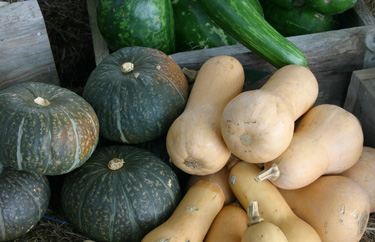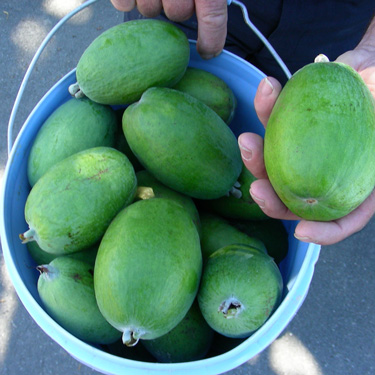Harvest time
Summer vege crops keep on giving until the first cold snap stops them in their tracks or it’s time to make space for autumn planting. When the first frost is a month or so away, some tricks of the trade will maximise yield, flavours and storage life.
Pumpkins
To accelerate ripening, trim off any leaves that are shading pumpkins. Test for ripeness by gently knocking with your knuckles. Ripe pumpkins sound hollow. Another indicator of ripeness is when vines begin to die off. Cut pumpkins with secateurs leaving a 10cm stem to prevent storage rot. Pumpkins bruise easily so handle them with care. Washing with a 10% bleach solution can also improve their storage life. Leave them in the sun for about two weeks, protecting with frost cloth if necessary. Pumpkins will last for up to six months if stored in a cool, dark airy shed. Place them upright in single rows for maximum ventilation and check regularly, using any that show signs of rot.
Tomatoes
Removing new flower clusters redirects the plants energy into ripening existing fruit instead of producing new fruit which won't have time to mature. Fruit that is still on the plants when it’s time to make space in the garden will continue to ripen if the pulled plant is hung in a cool dry shed. Picked fruit will continue to colour on a window sill, although flavour is compromised once the fruit is of the vine. Never store unripe tomatoes in the fridge as this inhibits ripening and diminishes flavour. Turn excess into sauces, chutney and relish to use over winter. If there is room in the freezer you can simply place whole tomatoes in bags for later cooking.
Capsicum
Peppers and chillies ripen quickly in autumn but can be picked at any stage from green to red, depending on the required flavour. Peppers deteriorate very fast when past their peak ripeness so pick them frequently. Excess peppers can be sliced and frozen or turned into relish and chutney. Hot chilli peppers increase in hotness as they ripen from green to red. Both colours freeze well whole in snapback bags. Or string them up in the kitchen as attractive "ristras" that will slowly dry for use over winter.
Potatoes
Autumn is harvest time for main crop potatoes which are ready to dig when the plants have died down. Get the whole family involved. Children love to be part of this rewarding experience. The skin of the tuber should have set (not rub off easily). Ideally, dig them on a dry, windy day. Any damaged tubers should eaten first as they are no good for storing. Don’t wash off the soil as this may damage the skin allowing disease entry. Spread tubers out in a shaded, well ventilated place to dry for a day or so. Don’t leave them in the sun or they will turn green and inedible. Once dry store then in paper bags or sacks in a cool, dry, well ventilated place. Too much light will turn them green. Properly stored main crop potatoes should last for up to 6 months, until the spring crop is ready for digging. Check regularly and remove rotten potatoes before they affect the rest.
Onions
Leave onions in the ground until at least 80% of the tops have dried off. Bend the rest over and leave for another 10-14 days for onions to mature. Pull them from the ground on a dry sunny day then leave them to dry in the sun for another 2–3 days. Once the root system is dry and brittle it’s time for curing: Trim tops to about 3cm long then spread the bulbs in a warm, dry, well ventilated place away from direct sun for 2–3 weeks, turning a few times to aid drying. For storing, hang onions in mesh bags in a dry shed.
Apples and pears
Fruit beginning to drop from the tree is a hint that it’s ready to pick. Fruit is ready when it reaches full colour and separates easily from the spur without breaking the stem. Later maturing varieties last longest without loosing quality. Long term storage requires refrigeration, so most home crops are stored by old-fashioned bottling or cooking and freezing.
Figs
Figs must be fully ripe before picking, and the birds are the first to notice. Bird netting comes in handy if you’re not keen to share the bulk of your crop with these feathered friends. Ripe figs are soft to the touch with full colour development and bend at the neck. Unripe figs exude white sap from the stem when picked and will not ripen once picked. Delicious dried figs will last 6 – 8 months and if you have a fig tree, a dehydrator might be a great investment. Otherwise they can be tuned into jams and chutneys or cooked and frozen for using later in cakes and condiments.
Feijoas
Feijoa's will not ripen once they are off the tree. If you don’t want to pick them off the ground (where they quickly rot) daily ’touch picking’ daily is the alternative. Ripe fruit comes away cleanly and easily when gently pulled. Bounteous feijoas are too often left to rot. Get the kids to set up a street side stall or give them away to friends and neighbours. Excess can be made into jams and chutneys or cooked and frozen for winter muffins and desserts.

1-Mar-2020


Pumpkins and squash

Tomatoes

Figs

Feijoas

